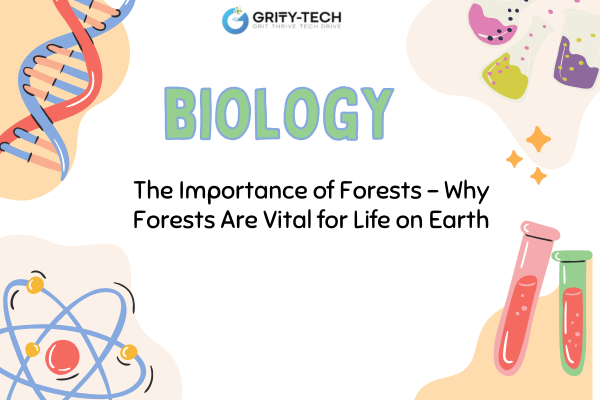Introduction – What Is Respiration?
Respiration is the process by which living organisms break down food (like glucose) to release energy. This energy is essential for growth, movement, and other vital functions. While we often think of respiration as just breathing, it’s much more than that! It happens at a cellular level and involves a series of steps that allow organisms to get the energy they need.
Through respiration, organisms transform the food they consume into usable energy that powers their cells, tissues, and organs. Let’s dive deeper into how respiration works in living beings!
expert-led Biology classes – visit our website to learn more
Types of Respiration
There are two main types of respiration:
- Aerobic Respiration – Requires oxygen.
- Anaerobic Respiration – Does not require oxygen.
Let’s explore these types in more detail.
Aerobic Respiration – Breathing in Oxygen
Aerobic respiration happens when organisms use oxygen to break down glucose and produce energy. This is the most common form of respiration and happens in the mitochondria of cells.
In this process, glucose from the food we eat reacts with oxygen from the air we breathe, and the result is energy, which our cells use for various functions. This energy is stored in molecules called ATP (Adenosine Triphosphate), which cells use to carry out work.
Here’s how it works:
The Process:
- Glucose (from food) reacts with oxygen.
- The reaction produces carbon dioxide, water, and energy.
Equation:
Glucose+Oxygen→Carbon Dioxide+Water+Energy (ATP)\text{Glucose} + \text{Oxygen} \rightarrow \text{Carbon Dioxide} + \text{Water} + \text{Energy (ATP)}Glucose+Oxygen→Carbon Dioxide+Water+Energy (ATP)
This energy is stored in molecules called ATP, which cells use to perform functions like movement, growth, and repair.
Where It Happens:
Aerobic respiration occurs in the mitochondria, which are like tiny powerhouses inside each cell.
Anaerobic Respiration – Energy Without Oxygen
Anaerobic respiration happens when there is no oxygen available. Organisms use this process to get energy when oxygen is scarce, like during intense physical activities when muscles run out of oxygen.
This type of respiration is not as efficient as aerobic respiration, but it provides a quick burst of energy when needed. It’s a backup system that kicks in when oxygen cannot be delivered quickly enough to cells.
Here’s what happens during anaerobic respiration:
The Process:
- Glucose is broken down without oxygen.
- The result is energy, but instead of producing carbon dioxide and water, lactic acid is produced in animals, and ethanol and carbon dioxide are produced in some yeast and plant cells.
Equation (in animals):
Glucose→Lactic Acid+Energy\text{Glucose} \rightarrow \text{Lactic Acid} + \text{Energy}Glucose→Lactic Acid+Energy
Equation (in yeast and plants):
Glucose→Ethanol+Carbon Dioxide+Energy\text{Glucose} \rightarrow \text{Ethanol} + \text{Carbon Dioxide} + \text{Energy}Glucose→Ethanol+Carbon Dioxide+Energy
Where It Happens:
Anaerobic respiration takes place in the cytoplasm of the cell.
While anaerobic respiration gives quick energy, it’s not as efficient as aerobic respiration, and it produces waste products like lactic acid, which can lead to fatigue and muscle soreness after intense exercise.
Why Do We Breathe? – Respiration in Humans
Humans and many other animals rely on aerobic respiration for most of their energy needs. When we breathe in oxygen, our body transports it to cells where it’s used in the mitochondria to produce energy. The waste product, carbon dioxide, is then expelled when we exhale.
In moments of intense physical activity (like sprinting), our muscles may temporarily switch to anaerobic respiration when they run low on oxygen. This is why we sometimes experience a burning sensation in muscles after heavy exercise—thanks to the lactic acid produced!
Respiration in Animals
Just like humans, animals also use aerobic respiration for energy. However, some animals, like birds, have highly efficient respiratory systems, with specialized structures like air sacs that allow for a continuous flow of oxygen, even during both inhalation and exhalation. This helps them sustain high energy levels during flight.
Respiration in Plants
Even though plants don’t “breathe” in the way animals do, they still carry out respiration. They use oxygen to break down glucose in their cells and release energy. However, unlike animals, plants take in oxygen during the night (when photosynthesis isn’t happening) and release carbon dioxide.
Plants rely on aerobic respiration for energy, but during the day, they balance it with photosynthesis, where they take in carbon dioxide and release oxygen. The cycle of photosynthesis and respiration is crucial for maintaining the balance of gases in the atmosphere.
FAQs – Curious About Respiration?
Q1: Why do we need oxygen for respiration?
Oxygen is essential for aerobic respiration because it helps break down glucose and release energy efficiently. Without oxygen, we would rely on less effective anaerobic respiration.
Q2: Can all organisms perform anaerobic respiration?
No, only certain organisms can perform anaerobic respiration, such as yeast and some bacteria. Animals, including humans, generally rely on aerobic respiration.
Q3: What’s the difference between breathing and respiration?
Breathing is the process of taking in oxygen and releasing carbon dioxide. Respiration is the cellular process that uses oxygen to produce energy.
Fun Facts About Respiration
- Plants also “breathe” at night! They take in oxygen and release carbon dioxide when there’s no sunlight for photosynthesis.
- During intense exercise, your muscles may temporarily switch to anaerobic respiration, causing lactic acid buildup, which makes your muscles sore the next day.
- A human body contains about 37.2 trillion cells, all of which carry out respiration to keep us alive and moving!
Conclusion – The Power of Respiration
Respiration is the life force behind every living organism. Whether it’s the steady flow of oxygen to human cells or a plant quietly breaking down glucose in the dark, respiration provides the energy needed to keep everything alive and functioning. From aerobic to anaerobic processes, understanding respiration helps us appreciate the hidden forces that power all living things!








